World
Imprisoned and exiled, a Nicaraguan activist rebuilds her life in the US
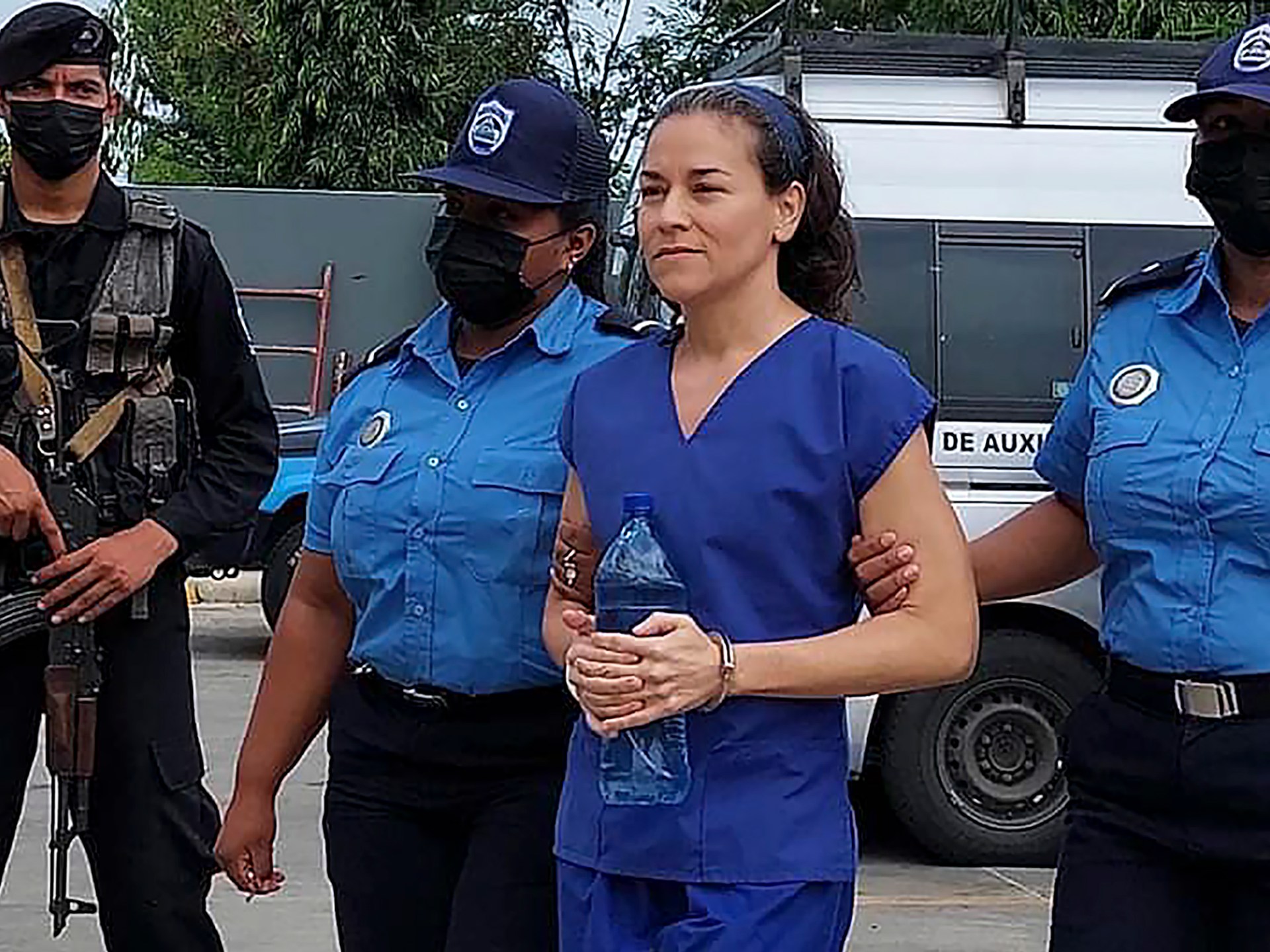
As her isolation in Nicaragua’s infamous El Chipote prison stretched month after month, Tamara Davila held fast to the conviction that she would one day be free to see her daughter again.
But freedom would ultimately take her farther away than ever. Six months ago, on February 9, Davila was one of 222 Nicaraguan political prisoners packed onto an aeroplane and sent into exile in the United States, there to face an uncertain future.
Even now, Davila struggles to describe how she felt boarding the plane.
“It was crazy. It was a mix of feelings — of joy but, at the same time, this sensation of losing everything,” she told Al Jazeera in a recent telephone interview. “Because my daughter was staying in the country. My house, all the things that I knew stayed there.”
What Davila and the other former prisoners found abroad was not an end to their punishment but a continuation of their struggle. Far from home, their Nicaraguan citizenship would be stripped and their property confiscated as the government of President Daniel Ortega branded them “traitors to the homeland”.
“It was not easy. It is still not easy,” Davila said.
A former rebel leader in the left-wing Sandinista movement, Ortega has been in and out of power since the late 1970s. But in recent decades, he has faced mounting criticism for his repressive stance towards activism and dissent.
As recently as June, the United Nations expressed concern that Nicaragua was “actively silencing any critical or dissenting voices in the country”. It noted that media outlets had been forced to shutter and other organisations had seen their legal status revoked — including 3,200 groups in the previous year alone.
State violence, however, hit a zenith in 2018, when cuts to social security sparked widespread anti-government protests. The Inter-American Commission on Human Rights has estimated at least 355 people died in subsequent clashes with security forces.
That was when Davila started to become more politically involved. Raised in a family that taught her not to be indifferent to suffering, Davila said she had long been drawn to feminism — another target of state repression.
“When movements cannot be controlled, it’s hard for any government,” said Victoria Gonzalez-Rivera, a professor at San Diego State University who studies women’s rights and LGBTQ history in Nicaragua.
“A trademark of feminism is women making their own decisions and being politically independent. And that generally clashes with most political parties and most governments.”
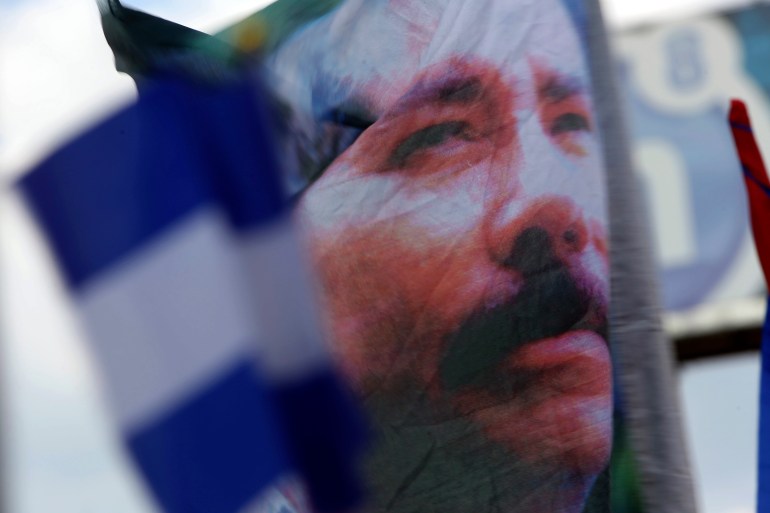
Years of activism
Davila felt particularly compelled to act because of the violence facing women in Nicaragua. One study published in 2020 (PDF) estimated that 27 percent of Nicaraguan women experienced intimate partner violence in 2016.
“The women that are in the country and need to be helped because they are suffering violence, they don’t have anywhere to go, because the state is not providing this medical attention,” Davila said. “And the women’s organisations that were doing that work, they don’t exist any more because the regime has cancelled those organisations.”
Davila ultimately found her passion for human rights reflected in the progressive political party UNAMOS, part of a coalition that formed in 2018 against Ortega’s government. But she was young, female and outspoken. That made her a target, she said.
“There were few women who were really visible at that moment in the national political sphere,” Davila, now 42, said. “We were using our voices to denounce the regime and dispute its power, even from a position of repression.”
In June 2021, with presidential elections fast approaching, the Ortega government began arresting political rivals — including the leader of UNAMOS, Suyen Barahona, and members like Davila.
They were taken to El Chipote, a prison north of the capital Managua that is infamous for what the UN termed “inhuman conditions”.
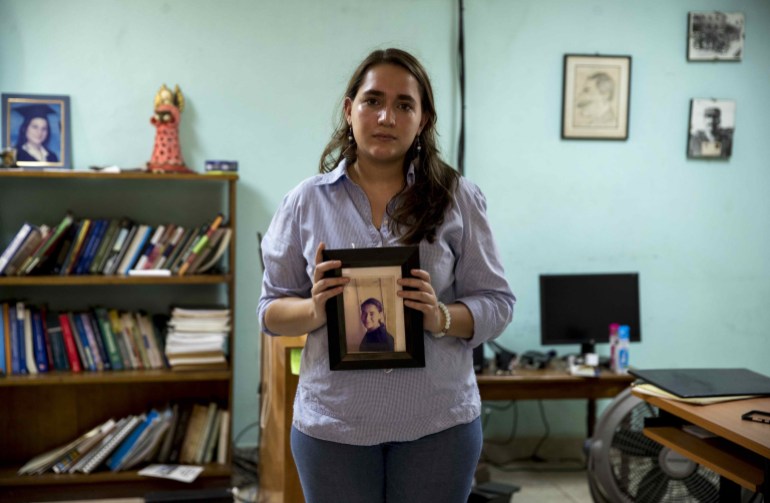
‘I knew I would leave’
Davila’s first days there were in complete isolation. The walls of her cell were thick: She could see no one, she recalled. Her only interactions came when the guards slid food through a slot in the door.
“It was horrifying,” she said. But she promised herself she would leave stronger than ever. After all, she thought, her five-year-old daughter needed her to stay healthy.
“I started to do my routine. I woke up early. I walked. I did exercises. I prayed. I sang. I did everything to make the time inside pass fast,” Davila explained. “I knew I was going to get out of there. I didn’t know when. But I knew I would leave one day.”
Six hundred and seven days ultimately passed. At the end, Davila began to suspect the guards were preparing to transfer her to a prison in Tipitapa. It was only when they placed her on a bus to the airport that she realised they had another destination in mind.
“One of the police officers came to us and brought to me a paper that I should sign. And the paper said that I will be transferred to the United States,” she said.
As she climbed onto the waiting plane, she noticed familiar faces: activists she had known before her incarceration. An official greeted her as she boarded, “Welcome to the United States, Tamara. You are free.”
But her mind started to whirl. What would she do in the US? What about her daughter? Her house? Her life and family in Nicaragua? Flooded with emotion, she began to cry.
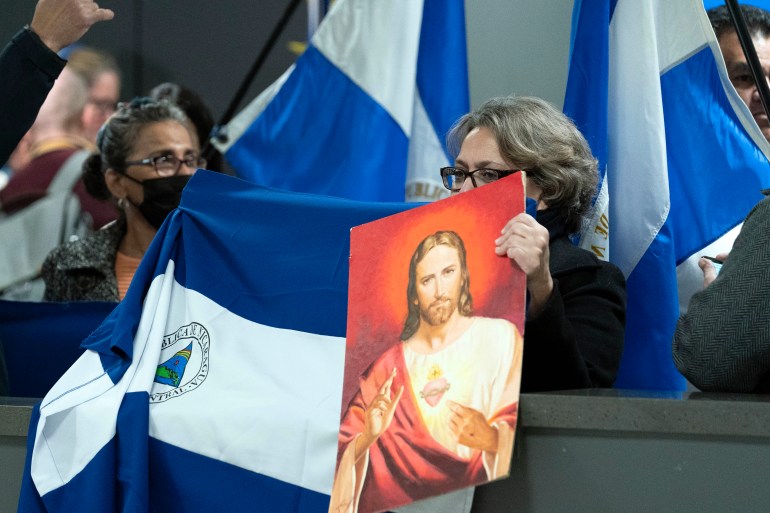
Psychological toll
Elizabeth Nugent, a Princeton University professor who studies activists in exile, said the experience can be “a major trauma” for someone dedicated to advocacy. “This really is a committed nationalist who was trying to reform their country,” she told Al Jazeera.
Nugent said being in exile can sometimes get conflated with other categories of migration in ways that erase the challenges associated with it. Refugees may not have been politically active in the same way an exiled activist has. And Nugent bristled when exile is framed as a kind of “freedom”.
“There’s often this assumption that things are so much better when you leave. There are lots of issues with that,” Nugent said. “Marginalised communities are marginalised everywhere.”
Exile is also no guarantee of safety, she added. Dissidents can continue to be targeted through transnational repression, which can involve efforts to intimidate an activist abroad — or threats against family members who stay behind.
“Being removed physically doesn’t protect an individual activist from the physical repression of the home regime,” Nugent explained.
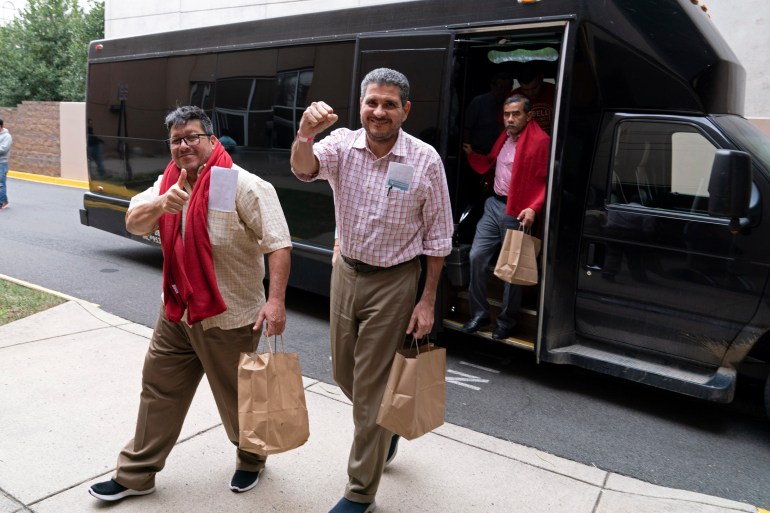
Hurdles of life in US
When Davila and the other former political prisoners landed in Washington, DC, they were quickly shuttled to a hotel near the airport.
Over the next few days, officials helped her and other exiled dissidents contact family members who might house them. The US had offered them two years’ stay in the country. Spain, meanwhile, extended citizenship to the exiled dissidents after Nicaraguan legislators voted to strip them of their nationality days after their departure.
“For me, it was like: I don’t care if they do that. I’m still a Nicaraguan woman,” said Davila of losing her citizenship. “But in practical, day-to-day life, you need your documents for living these days.”
Paperwork also proved a hurdle when it came to reuniting with her daughter, who had been staying with Davila’s mother and sister in Nicaragua. Her child did not yet have a passport, and Davila feared what might happen if she applied for one with the Nicaraguan government.
The only solution seemed to be to leave the country irregularly, so Davila’s mother, sister and daughter crossed the border into Costa Rica and applied for the child’s travel documents there.
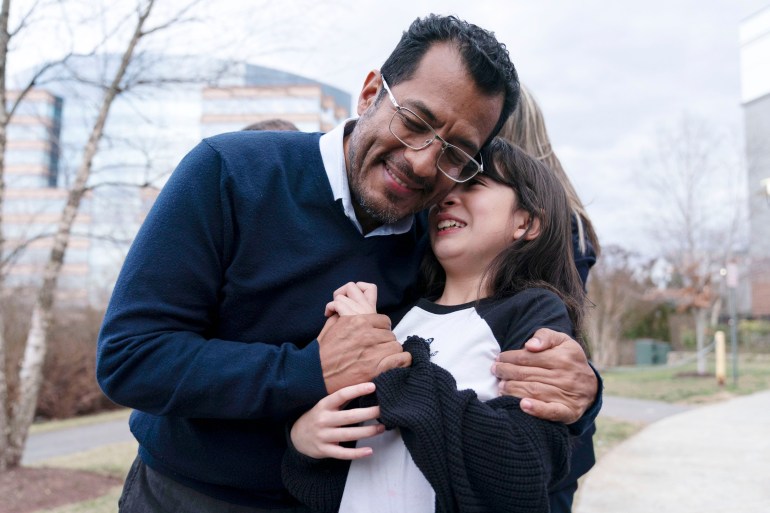
By the time Davila’s daughter finally arrived in the US, it was April. And the five-year-old Davila remembered had grown into a seven-year-old with the same green eyes, the same inquisitiveness — and yet somehow different.
Her daughter had a similar reaction. The little girl took Davila’s face in her hands, inspecting how thin she had become since her incarceration, how long her hair had grown. “Mom, how different you are,” the child remarked.
The reunion was “magic”, Davila recalled. “It was just at that moment that I became truly free.”
Adapting to life in a new country has not been easy, though. “We’re living together day by day,” said Davila. “‘Un dia a la vez,’ as we say in Spanish. ‘One day at a time.’”
Ultimately, she remains optimistic she can continue to work for change in Nicaragua, even from afar. “We will have democracy in my country,” she said. “Sooner rather than later, we’ll have it.”

World
What a judge's gag order on Trump means in his hush money case
NEW YORK (AP) — Virtually every day of his hush money criminal trial, former President Donald Trump talks about how he can’t talk about the case.
A gag order bars Trump from commenting publicly on witnesses, jurors and some others connected to the matter. The New York judge already has found that Trump, the presumptive Republican nominee for president, repeatedly violated the order, fined him $9,000 and warning that jail could follow if he doesn’t comply.
But the order doesn’t stop Trump from talking about the allegations against him or commenting on the judge or the elected top prosecutor. And despite a recent Trump remark, it doesn’t stop him from testifying in court if he chooses.
As he fights the felony charges against him while running for president, Trump has at times stirred confusion about what he can and can’t do in the case. He has pleaded not guilty.
So what does the order do, what doesn’t it and where did it come from?
WHAT IS A GAG ORDER?
Generally speaking, a gag order is a judge’s directive prohibiting someone or people involved in a court case from publicly commenting about some or all aspects of it. In Trump’s case, it’s titled an “Order Restricting Extrajudicial Statements,” with “extrajudicial” meaning outside of court.
Gag orders, particularly in high-profile cases, are intended to prevent information presented outside a courtroom from affecting what happens inside.
Trump also is subject to a gag order in his federal criminal election interference case in Washington. That order limits what he can say about witnesses, lawyers in the case and court staff, though an appeals court freed him to speak about special counsel Jack Smith, who brought the case.
In his recent New York civil fraud trial, Trump was fined a total of $15,000 for comments he made about that judge’s law clerk after a gag order barred participants in the trial from “posting, emailing or speaking publicly” about the court’s staff.
The U.S. Supreme Court has acknowledged that gag orders can pit fair trial rights against free speech rights. The court has struck down some orders that barred the press from reporting on certain cases or court proceedings and rejected as too vague a Nevada court rule that limited what all lawyers could say out of court.
IS TRUMP FIGHTING THE GAG ORDER?
Yes. Before the trial, he asked a state appeals court to postpone the trial while he appeals the gag order, but the court refused. His appeal of the order itself is ongoing.
WHO IS COVERED BY THE GAG ORDER ON TRUMP?
Initially imposed March 26, the gag order bars Trump from making or directing others to make public statements about any juror and about any “reasonably foreseeable” witness’ participation in the investigation or the trial.
It also bars any statements about lawyers in the case, court staffers, prosecution aides and relatives of all of the above, to the extent that the statements are intended to “materially interfere with, or to cause others to materially interfere with” their work on the case “or with the knowledge that such interference is likely to result.”
The order doesn’t apply to Judge Juan M. Merchan or to Manhattan District Attorney Alvin Bragg, whose office is bringing the case. It does apply to comments about their family members, however. Merchan added that provision on April 1 after Trump lashed out on social media at the judge’s daughter, a Democratic political consultant, and made a claim about her that was later repudiated by court officials.
Trump is also allowed to talk about his political opponents, as Merchan made clear on Thursday.
The order also doesn’t bar witnesses from commenting on Trump. Michael Cohen, Trump’s ex-lawyer and an expected witness, has routinely attacked his former boss, leading Trump to complain about not being able to respond in kind.
CAN TRUMP TESTIFY?
Yes. The U.S. Supreme Court has held that criminal defendants have a constitutional right to take the stand in their own defense — or not to.
There was some confusion after Trump said Thursday that because of the gag order, he was “not allowed to testify.” In context, it appeared he was actually referring to his ability to respond to a reporter’s court-hallway question about a witness’ testimony that afternoon.
Trump clarified to reporters Friday that he understood the order wasn’t a bar on testifying. Merchan emphasized the same in court.
“I want to stress, Mr. Trump, you have an absolute right to testify at trial, if that’s what you decide to do after consultation with your attorneys,” Merchan said.
WHY DID TRUMP GET FINED? WHAT CAN’T HE SAY?
Merchan found that Trump violated the gag order with social media posts that laid into Cohen. Among the offending posts: one that asked whether “disgraced attorney and felon Michael Cohen been prosecuted for LYING,” a repost of a New York Post article that described Cohen as a “serial perjurer,” and a Trump post referring to Fox News host Jesse Watters’ claim that liberal activists were lying to infiltrate the jury.
Merchan noted that Trump’s comment on the Watters segment misstated what the host had actually said, making the comment “the words of Defendant himself.”
On the other hand, Merchan declined to sanction Trump for an April 10 post that referred to Cohen and Stormy Daniels, the porn performer who got a $130,000 hush money payment that’s at the heart of the case, as “sleaze bags.”
Trump contended that he was responding to previous comments by Cohen, and the judge said the back-and-forth gave him pause as to whether that post met the bar for a violation.
COULD TRUMP REALLY GO TO TO JAIL OVER THE GAG ORDER?
When Merchan fined Trump $1,000 apiece for nine violations — the maximum fine allowed by law — he wrote that “jail may be a necessary punishment” for some wealthy defendants who won’t be deterred by such a sum.
Merchan added that he “will not tolerate continued willful violations” of the gag order and that, if “necessary and appropriate,” he “will impose an incarceratory punishment,” meaning jail.
It’s unclear what would rise to the level of “necessary and appropriate.”
Defense lawyer Todd Blanche indicated in court Friday that he plans to appeal the judge’s finding this past week that Trump violated the gag order.
Prosecutors have asked Merchan to hold Trump in contempt again and fine him $1,000 for each of four alleged violations from April 22-25. But the prosecution isn’t asking for the former president to be locked up over those comments because they happened before Merchan’s jail warning and because “we’d prefer to minimize disruption to this proceeding,” prosecutor Christopher Conroy said.
World
Fourth body found in search for US and Australian surfers who mysteriously vanished in Mexico
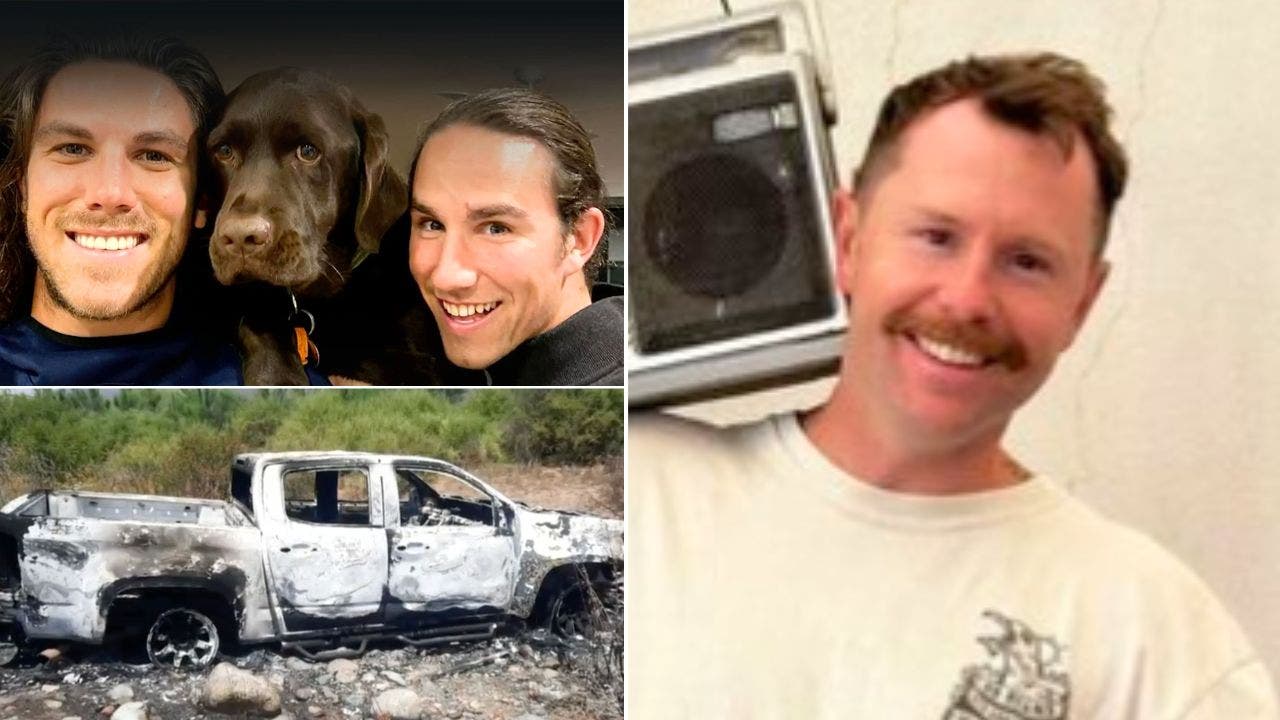
A fourth body has reportedly been discovered in a popular Mexican tourist area, where an American and two Australians vanished last week while on an apparent camping and surfing trip, the local prosecutor’s office said in a statement late on Friday.
American Jack Carter Rhoad, 30, as well as Australian brothers Callum Robinson, 33, and Jake Robinson, 30, were last seen on April 27, the Baja California state prosecutor’s office previously announced. They did not show up at their planned accommodation last weekend.
Investigators discovered three bodies dumped in a pit while searching for the trio on Friday, although officials have not confirmed if the bodies are those of the missing men.
The fourth body was found nearby, the New York Post and other outlets reported. It’s unclear if it’s connected to the other three.
2 AMERICANS FOUND DEAD IN HOTEL ROOM IN MEXICO’S BAJA CALIFORNIA
Australian brothers Callum Robinson and Jake Robinson, top left, and US citizen Jack Carter Rhoad, right, who are missing in Mexico. (Reuters)
Forensic tests on the remains will be conducted by a state laboratory, which will allow for positive identification of the bodies, the prosecutor’s office said in its statement.
Investigators continue to search the rugged area where the bodies were found for additional evidence, the statement added.
The bodies were found in a rugged hillside area in the Mexican state of Baja California near the popular tourist town of Ensenada, about 90 minutes south of the U.S.-Mexico border. Video from the scene shows rescuers installing ropes to enter the pit where the bodies were discovered. The site is cordoned off by police, while a navy boat was also visible in the sea nearby.
The site where the bodies were discovered near the township of Santo Tomás, was near the remote seaside area where the missing men’s tents and the burned-out Chevrolet Colorado pickup truck were found Thursday on a remote stretch of coast.
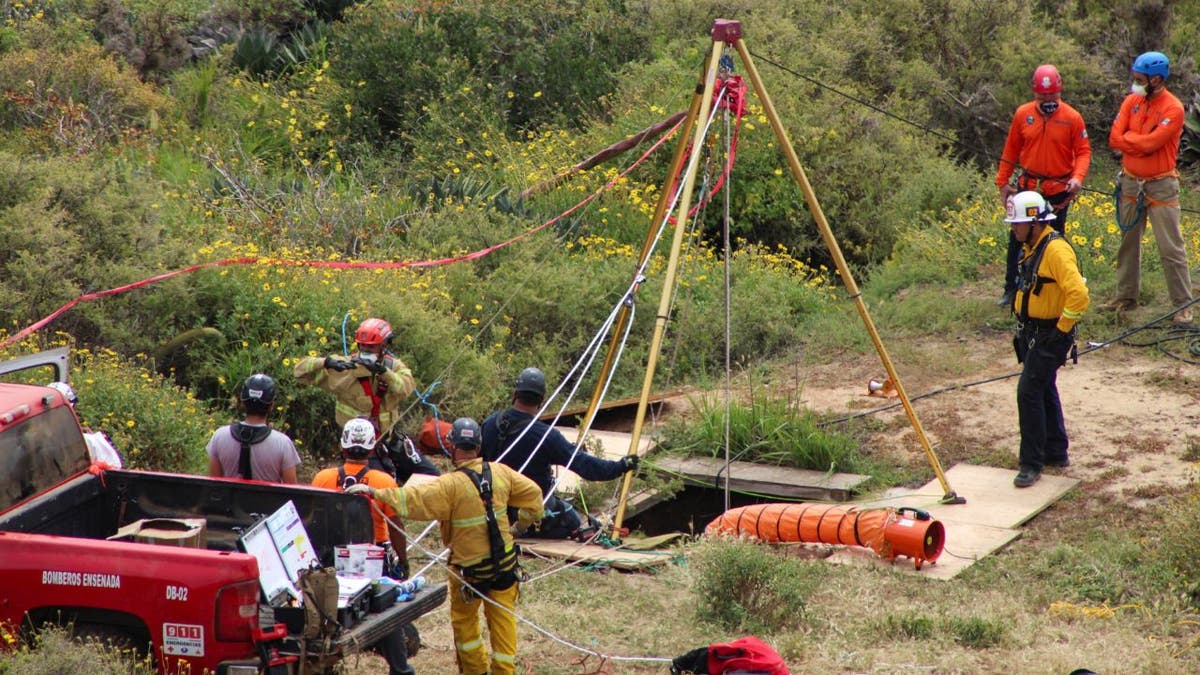
Members of a rescue team work at a site where three bodies were found in Baja California. The team have been looking for one American and two Australian tourists who have been reported missing. (Reuters)
It is unclear what types of injuries the victims suffered or how they died.
“There is a lot of important information that we can’t make public,” María Elena Andrade Ramírez, the chief state prosecutor said.
Baja California prosecutors said Friday that three people had been arrested and charged with a crime equivalent to kidnapping. It was unclear if they might face more charges.
Ensenada Mayor Carlos Ibarra Aguiar said in a news release that a 23-year-old woman had been detained with drugs and a cellphone that had a wallpaper photo of one of the missing men, The San Diego Union-Tribune reports. Officials didn’t specify how the three people were connected to the investigation, saying only that some were directly involved and others indirectly.
LUXURY RESORT SHUTTERS IN MEXICO’S BAJA CALIFORNIA AFTER MYSTERIOUS DEATHS OF 2 AMERICANS

A missing persons’ poster of the trio was distributed earlier this week. (Reuters)
Investigators said that a missing persons report was filed 48 hours after the men were last seen, although the prosecutor’s office began investigating as soon as posts began circulating on social media.
María Elena Andrade Ramírez, the chief state prosecutor, said that while drug cartels are active in the area, she said, “all lines of investigation are open at this time. We cannot rule anything out until we find them.”
The Baja California Attorney General’s Office has said that it has maintained contact with the FBI and relatives of the victims, through consular agencies.
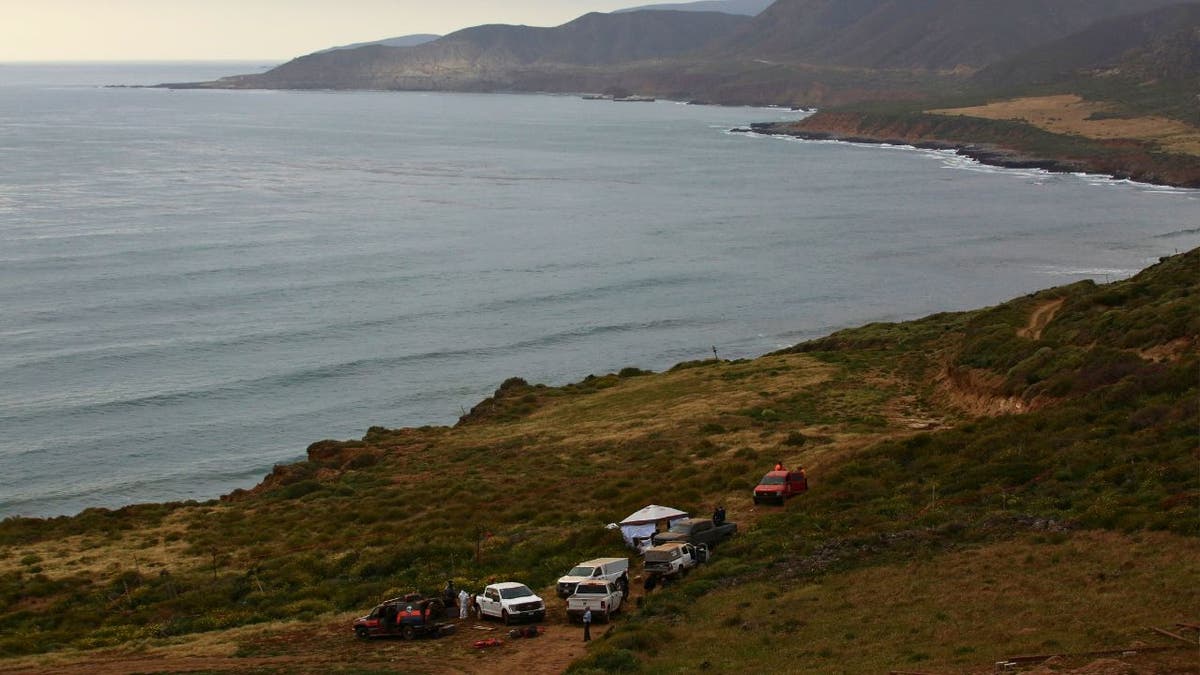
Members of a rescue team work at a site where three bodies were found in the state of Baja California where one American and two Australian tourists were reported missing.
On Wednesday, the missing Australians’ mother, Debra Robinson, posted on a local community Facebook page an appeal for help in finding her sons and noted that Callum is diabetic.
The Australian media reports that Jake is a doctor, while Callum lives in San Diego and is a member of Australia’s national lacrosse team.
The State Department’s travel advisory lists Baja California under its “reconsider travel” category due to crime and kidnapping.
In 2015, two Australian surfers, Adam Coleman and Dean Lucas, were killed in western Sinaloa state, across the Gulf of California — also known as the Sea of Cortez— from the Baja peninsula. Authorities say they were victims of highway bandits.
Reuters and The Associated Press contributed to this report.
World
German socialist candidate attacked before EU elections

Matthias Ecke, a member of Germany’s centre-left Social Democratic Party, was attacked on Saturday while out campaigning.
A candidate for Chancellor Olaf Scholz’s centre-left party in next month’s European Parliament election has been seriously injured while campaigning in eastern Germany, the party said on Saturday.
Matthias Ecke, a Social Democrats (SPD) candidate, was attacked while putting up political posters in Dresden on Friday evening, according to the party.
He was taken to hospital and required surgery for his injuries, it said.
Police said the 41-year-old was hit and kicked by four men and that the same group had apparently attacked a Green Party worker minutes before in the same street.
Interior Minister Nancy Faeser, also a Social Democrat, said if it’s proven that the assault on Ecke was politically motivated, it would represent “a serious attack on democracy.”
The attack was the latest in a series of incidents raising political tensions in Germany ahead of the European Parliament election.
Scholz’s SPD launched their official campaign for the 9 June vote with a rally last week in Hamburg, where the German leader grew up.
“We are experiencing a new dimension of anti-democratic violence,” Faeser said.
She promised “tougher action and further protective measures for the democratic forces in our country.”
Government and opposition parties say their members and supporters have faced a wave of physical and verbal attacks in recent months and have called on police to step up protection for politicians and election rallies.
Many of the incidents have occurred in the former communist east of the country, where the far-right Alternative for Germany party (AfD) is expected to make gains in the European elections and upcoming votes in Germany.
Last week, the car carrying the vice-president of the German parliament, Katrin Goering-Eckardt of the Greens, was surrounded for nearly an hour by protesters as she tried to leave a rally.
The opposition Christian Democrats and the Left party say their workers have also faced intimidation and seen their posters ripped down.
Mainstream parties accuse the AfD of links to violent neo-Nazi groups and of fomenting an increasingly harsh political climate. A prominent AfD leader, Bjoern Hoecke, is currently on trial accused of using a banned Nazi slogan.
Germany’s domestic intelligence service has placed some chapters of the party under surveillance.
The branch of the Social Democrats in Saxony state, where Ecke is their lead candidate for the European elections, said their campaign would go on despite “fascist methods” of intimidation.
“The seeds that the AfD and other right-wing extremists have sown are germinating,” the branch leaders, Henning Homann und Kathrin Michel, said in a joint statement. “These people and their supporters carry responsibility for what is happening in this country.”
-

 News1 week ago
News1 week agoFirst cargo ship passes through new channel since Baltimore bridge collapse
-

 World1 week ago
World1 week agoHaiti Prime Minister Ariel Henry resigns, transitional council takes power
-

 Movie Reviews1 week ago
Movie Reviews1 week agoAbigail Movie Review: When pirouettes turn perilous
-

 World1 week ago
World1 week agoEU Parliament leaders recall term's highs and lows at last sitting
-

 Politics1 week ago
Politics1 week ago911 call transcript details Democratic Minnesota state senator’s alleged burglary at stepmother's home
-

 Politics1 week ago
Politics1 week agoGOP lawmakers demand major donors pull funding from Columbia over 'antisemitic incidents'
-

 Science1 week ago
Science1 week agoOpinion: America's 'big glass' dominance hangs on the fate of two powerful new telescopes
-

 World1 week ago
World1 week agoHamas ‘serious’ about captives’ release but not without Gaza ceasefire



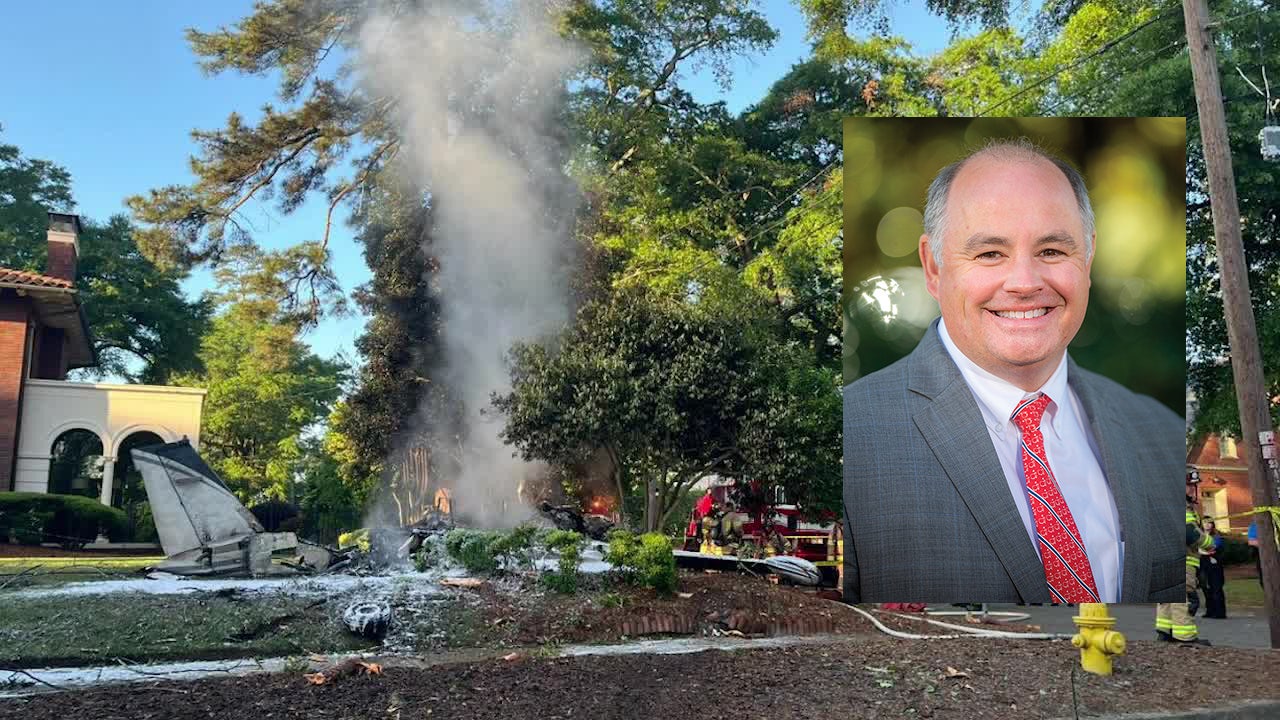

/cdn.vox-cdn.com/uploads/chorus_asset/file/25432052/installer.png)








